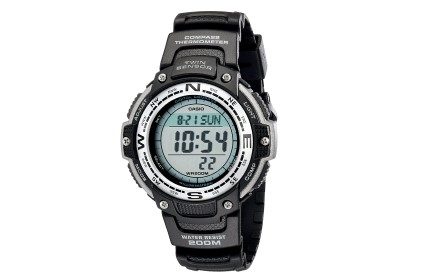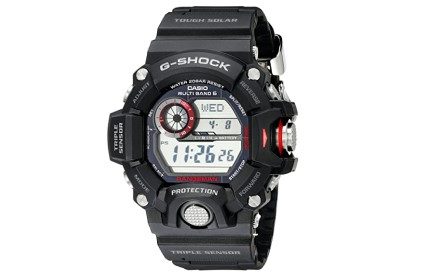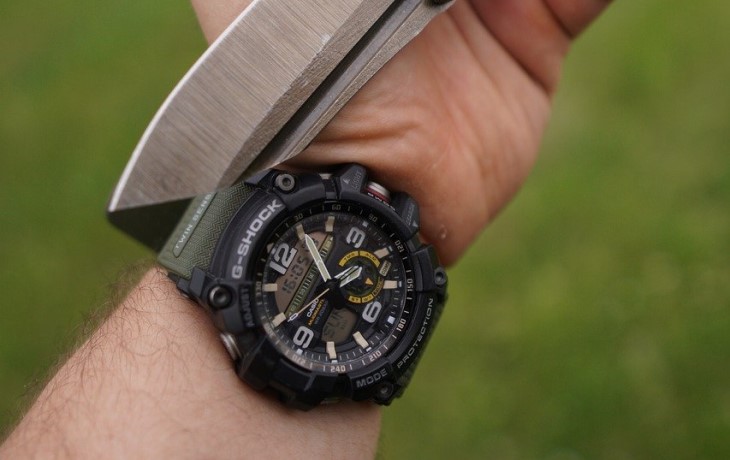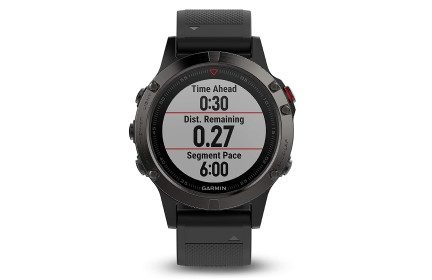Probably the watch’s most important attribute as a survival tool is that you always have it with you. A good watch isn’t likely to get left back at camp — it goes wherever you go, always available and feeding you valuable intel.
Summary:
- There isn’t really a “survival watch” product category, but so-called “tool watches” fit the bill.
- Bare-bones mechanical watches have more survival uses than you probably think, and digital watches are even more capable.
- Good watches for a variety of survival and emergency situations don’t have to be very expensive.
- Everyone’s watch needs will be slightly different, but certain demands are universal.
- Consider things like battery life, need to calibrate, and general upkeep when deciding if a particular watch is a good fit for your needs.
This guide gives you some idea of how to find a good survival watch in the current market, and what you should look for when selecting one.

Best for most people:
Casio SGW100 Twin Sensor Digital Watch
The Casio SGW100 Twin Sensor is easily found for under $45, it’s rugged as hell, and tells the time, day, and date accurately until 2099. This watch boasts a three-year battery life, and comes with a digital compass and thermometer. It’s cheap enough to be a daily beater, but delivers enough features and performance to more than justify its price. Just be aware that the compass requires calibration before use, and the thermometer should be removed from your wrist to give ambient temperature accurately.
There are other watches in this review that are more capable, but they’re also significantly more expensive. There’s a reason inexpensive Casio digital watches are often found in the collections of serious watch enthusiasts: They cost next to nothing and do their job reliably, and without complaint.

Rugged and reliable:
G-Shock Rangeman GW-9400
The G-Shock line from Casio is designed to deliver information and reliability first, and fashion second. That’s one of the reasons they’re so popular among the armed forces: A G-Shock may not be pretty, but it may take a bullet to shut one down completely. This is a watch that’s designed to take extreme abuse while still being there for you.
Pressing the sensor button brings you to a variety of sensor modes, and in a nice touch each one has its own tone, so you can tell what you’re looking for without using your eyes. The G-Shock Rangeman GW-9400 offers a digital compass, thermometer, barometric pressure sensor, and altimeter. There are five daily alarms so you can track everything from when you need to check in with home base to when you last took or administered medication. You also get day, date, month, and the daily times for sunup and sundown. The solar-powered battery means that you won’t have to worry about keeping the watch wound or changing the battery as long as you spend some time out in the sun.
This is also a completely self-contained watch, meaning that none of the information it delivers relies on external sources like a phone or laptop. There is no automatic movement that needs maintenance, and no winding to worry about or battery that will run down.
GPS smartwatch:
Garmin Fenix 5X Sapphire
If you’re willing to have (much) shorter battery life in exchange for fancier features — perhaps for recreational outdoor trips where you might end up in a survival situation due to being lost or stuck — a smart watch might be worth it.
The Fenix 5X Sapphire features color topographical maps, and storm alerts based on barometric pressure. It can track the phases of the moon, and let you know when to expect sunup and sundown, even giving you the option of setting up custom alarms with specific sounds for when those times of day are approaching. Want to know when you have 30 minutes until sundown? You can make it happen.
The sapphire crystal glass means that it’s going to be very challenging to scratch or crack the watch’s face, and the 100 meters of water resistance means you won’t have to worry about getting it wet. This is a watch that can absolutely take the abuse of a rugged, outdoors environment, while giving you an impressive amount of information about your surroundings.
We won’t even go into the fitness functions, apps, and customizable watch faces. These are all the icing on the cake, but they’re not as useful for prepping.
The downside is that, unlike the other survival watches we’re discussing, this one is going to need to be charged every 20 hours or so under full use. This is still an impressive feat considering how much information the watch is pulling in and displaying through it’s always-on screen, which remains legible in both the dark and under direct sunlight.
Still, carrying an inexpensive backup watch with a long battery is a good idea if you’re using this primarily for navigational purposes. The G-Shock line is filled with solid choices that can hold up in just about any conditions, with many being available for under $50.
Contenders
Although not currently top picks, these models are worth a look if you want more shopping options:
- Casio Men’s Pathfinder Triple Sensor Sports Watch
- Luminox Leatherback Sea Turtle
- Suunto Traverse Alpha
- Suunto Core All Black Military Outdoor Sports Watch
- Timex T49612 Expedition
Be prepared. Don’t be a victim.
Want more great content and giveaways? Sign up for The Prepared’s free newsletter and get the best prepping content straight to your inbox. 1-2 emails a month, 0% spam.
Survival watch features
There are a number of ways a watch can come in handy during an emergency, and these examples only scratch the surface.
- Telling time, including the day and date
- Timing how long it’s been since you’ve administered medication to yourself or others
- Showing the barometric pressure or offering early warning alarms for incoming rain or storms
- Set up a timer on the fly using watches with spinning bezels
- Some watches can even tell you where you are, where you need to go, or how to get back to where you started
- Telling the temperature, although many watches with this feature will need to be removed from the wrist to get an accurate reading
- Collecting sleep and heartbeat data to make sure you’re staying healthy and rested
- Providing basic navigation through built-in compasses
- Displaying your altitude
- Setting multiple alarms to track multiple necessary tasks and reminders throughout the day
There are many watch types on the market — dress watches, pilot watches, dive watches, racing watches — but there is no real category for “survival watches” (at least, not yet). So to pick a good watch for prepping, we’ll have to look into these other categories to find what we need.
Probably the most relevant general category of watches for preppers is the “tool watch.” The term “tool watch” isn’t a term of derision — it means a watch that was created with a specific focus on a niche or a set of scenarios, such as watches designed for pilots, race car driver, scuba divers, people working near strong electromagnetic forces, or anyone who needs a watch that has to survive what might be a very specific set of circumstances and deliver functionality in those environments beyond just telling time.
Rolex originally became popular as a brand that was focused, with laser-like intensity, on creating some of the best tool watches on the planet.
- The Rolex Milgauss, for instance, was designed so scientists in the ‘50s could work near strong magnetic fields without destroying the accuracy of their watches, not as a status symbol.
- Paul Newman made the Rolex Daytona famous by wearing it while he raced cars, not just by posing with it in his later years.
- The Rolex Yacht Master wasn’t originally meant to flaunt wealth, it featured fascinating innovations in watch design that aided the men and women who actually raced yachts.
- The Rolex Explorer is probably the closest thing Rolex makes to a true survival watch, as the company designed the watch to survive the summit of Mt. Everest. One was worn by Tenzing Norgay during the first successful attempt to reach the mountain’s peak, a journey he shared with Sir Edmund Hillary in 1953.
Tool watches, then, cover the basic watch functions of telling time (and often, date), and then add some specialty features like a chronograph, timer, altimeter, barometer, etc. All of these added tool watch features can come in handy in different prepping and emergency contexts.

Common watch features
All the watches selected in this guide should be more than up to the challenge of thriving in most challenging environments, but remember that each situation, like each watch, is different. Always start backward: Figure out what you need the watch to do, and also what you need it to survive, and then go shopping for the right model.
Falling in love with a watch only to have it fail in the field because you liked its looks more than its materials or construction is a worst-case scenario, and easily avoided by focusing on your needs for its use, and not your wants for its aesthetics or brand recognition. Remember, the goal is for the watch to be ready where and when you need it, not to always look its best.
Most watches have the following features that we’ll need to consider when picking a survival watch.
Battery life
Battery life can be wildly variable between different types of watches, depending on a number of factors. The G-Shock we recommend above, for instance, is charged by solar energy. Assuming you’re often out in the light, you’ll almost never have to worry about the battery giving out when you need it the most.
The Casio Twin Sensor watch, on the other hand, has a battery life of approximately three years.
The Garmin Fenix 5X will need to be charged frequently due to its screen and GPS functions, so you won’t be able to trust it for more than 20 hours or so, although assuming a battery life of closer to 15 hours is a safer bet. The last thing you want when you’re out in an area you’re unfamiliar with is your GPS going out suddenly.
Each of these options are more than adequate for the purposes they were designed for, but the important thing is what you’ll be using it for, and how long you’ll need to rely on the watch between battery replacement or charging sessions.
Power source
The ideal power source depends on what you’ll be doing with the watch, and how long you need it to last away from a power source. Many automatic watches are now powered by the movement created as you wear the watch, but that reserve begins to drain the moment you take it off. Only some models include a complication that shows how much power is left. This isn’t a huge deal in most situations, although it means if you take the watch off for more than a day or two you’ll need external time-keeping equipment to accurately set the time.
Be sure to look up the battery model, and estimated life of that battery, for any watch you need to rely on for survival. A battery-powered Quartz movement will run for years, but eventually that battery will still need to be replaced, so keeping your kit stocked with a few replacements should fulfill all your needs for years, if not decades. It’s worth the time and money to pick up a kit of tools that can replace the battery in just about any watch you need, and replacement batteries are inexpensive on Amazon. It’s always smart to practice changing the battery before you need to, just to make sure you know how to do so and you have the necessary tools. Don’t worry, though; it’s not a tricky process once you’ve done it a few times.
But if you want a watch that will run just about forever, solar-powered models only need light to keep running, a huge advantage if your goal is to put something on your wrist you can forget about when not in use.
Case material
Modern watches can be made out of almost anything — a few microbrands have released watches with meteorite dials. But what a watch is made of is much less important than how well that material can hold up to the conditions in which you’ll be using it. The stainless steel of the G-Shock series was picked to handle just about everything, although most watches use a variety of materials for both practical and aesthetic purposes. Most prepper-appropriate watches will have some combination of steel, rubber, resin, and plastic — all of these are solid, durable choices. Titanium is often a light but incredibly strong alternative that’s popular in certain field watches.
Material itself also isn’t everything when it comes to watches that need to withstand a lot of abuse. Two watches may be made out of the same material, but if one has a screw-down crown, where the crown is screwed down into the casing, it will be much more water resistant than a watch with a push-down crown.
Strap material
Straps can be made from a variety of materials, and follow our rule that function should always trump form. That distressed leather strap may make your watch look great, but it’s a poor choice for a watch that’s going to be spending a lot of time in the water.
The simplest solutions are resin or rubber straps, which do well in a variety of environments, aren’t bothered by water, fit well on a wide variety of wrists, and can be quickly resized if you need to loan your watch to a friend or borrow their watch.
Steel bracelets are of course stronger than resin or rubber, but they must be manually sized for each wrist that will be wearing it. The process doesn’t take longer than a few minutes once you have the right tools and a little practice, but you never know when those few minutes may be important. You’ll also want to make sure any steel strap has solid steel segments, as many inexpensive steel bracelets use folded segments that are much less durable than solid steel.
And of course there’s always the popular nylon strap, including NATO varieties that seem to be everywhere these days. Nylon is strong, it feels light on the wrist, especially on hot days, and it won’t be hurt by moisture or being submerged in water. NATO straps, with a little practice, are easy to put on and take off your wrist, switch between watches, and will keep your watch exactly where you want it without sacrificing comfort. There’s a reason these things are everywhere, and NATO straps are one of the easiest ways to add a splash of color to a watch without sacrificing usability.
Crystal / watch face
The crystal covers the watch face, and protects the display while keeping water, dust, or any other contaminants out. If the crystal is cracked or otherwise damaged, the integrity of the entire system may be compromised.
The best crystal for a prepper watch is sapphire, hands-down. It’s the most scratch resistant, and the most likely to stand up to the roughest abuse without cracking. It’s also a premium feature, so expect to only find it in higher-end watches (like the Garmin Fenix 5X Sapphire we recommend).
The Casio SGW1000 and G-Shock Rangeman GW-9400 both use mineral crystal. Mineral crystal is a popular choice for inexpensive or mid-range watches, and is relatively tough, but it’s definitely an area where many companies try to save a little money during production.

